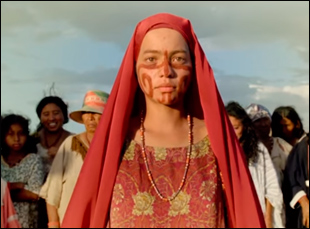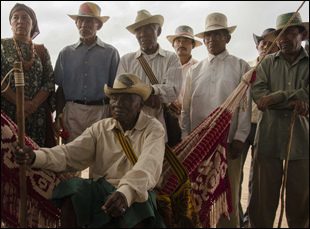There has long been mythmaking around the Colombian drug trade that flourished during the 1970s and early ‘80s, so it was only natural that Cristina Gallego and Ciro Guerra were attracted to the possibilities of it following their triumphant 2015 psychedelic adventure “Embrace of the Serpent,” which earned the filmmaking duo an Oscar nomination for Best Foreign Film. However, drawing on a connection to the indigenous Wayuu people that dated back to when the pair made the 2009 drama “The Wind Journeys” in the Guajira region, they sought to combat the legend that had sprung up around the larger-than-life activities of Pablo Escobar in Medellin with a spiritually-infused tale that was actually true to Colombia’s robust cultural history in “Birds of Passage,” which unfolds like a folk tale by way of “The Godfather.”
Gallego and Guerra, co-directing together for the first time after long operating as a producer-director team, bring the full weight of Wayuu tradition into tracing the rise and fall of Rapayet (José Acosta), a young man of disreputable provenance who wants to marry Zaida (Natalia Reyes), a member of the prominent Pushaina family, yet finds the only way he can afford a dowry of “30 goats, 20 cows, five necklaces and two decorative mules” would be to turn towards selling the increasingly lucrative marijuana crops being grown by Zaida’s relative Aníbal (Juan Martínez). With his friend Moncho (Jhon Narváez), Rapayet quickly amasses far more than necessary, yet still not enough for either himself or his new mother-in-law Ursula (a ferocious Carmiña Martínez), who clearly revels in accumulating material objects that the rest of the community has long resisted, and the film comes to question what is fundamentally lost when values are dictated by money more than anything else.
As a crime saga, “Birds of Passage” is gripping, but the film becomes truly harrowing in depicting the collapse of the Pushainas and by extension the Wayuu way of life, demonstrating just how such a rich legacy that’s made evident by showcasing bewitching rituals and extraordinary garments and music can be warped and corrupted into something unrecognizable, at least to those living inside of it since the story of greed Gallego and Guerra tell is a tale as old as time. Following the its premiere at Cannes last year where it was generally regarded among the best films at the festival, the film is finally arriving in America and recently the filmmakers were in Los Angeles to discuss negotiating a collaboration with the Wayuu people to do justice to their story, finding elegant solutions to mark the passage of time in a film that spans multiple decades, and the important conversations “Birds of Passage” has sparked at home.

Cristina Gallego: Yes, that was a natural step for our creation together. We have a great collaboration – it’s very strong – and it has been very different from each film to the other, [which] gave me the confidence also to assume that I can co-direct. When we started the script process and we [went] deep into the research, we knew that we can renew the genre and make something that would be very different if we can tell this history from a female point of view because it was set in a matriarchal society. And this is a point of view I can bring if I take the direction together with Ciro.
Ciro Guerra: We [also] weren’t happy with the way [previous] stories have represented the Colombian experience. We don’t feel that the representation has been fair because there’s been a lot of glamorization of violence and the Narco aesthetic, it’s seen as something cool now. There are a lot of people who look up to Pablo Escobar, but we felt that this process has really been a tragedy for Colombia. It has been the destruction of the moral basis for our society and we felt that this story gave us the opportunity to offer the other point of view. So it was an opportunity to tell a story that people didn’t know about and in doing so, offered the other side of the coin, a representation that is more fair to what we’ve experienced.
I’ve read there were negotiations with the Wayuu before embarking on the production – what shape was the script in when you approached them? Did those conversations contribute to the film in creative ways?
Ciro Guerra: Yeah, the starting point for the script were the stories that people from the region were sharing with us about what happened during this time. It is like an urban legend for the people who live in the north of Colombia, and it was sort of forbidden. It was known and discussed during the early ‘80s, but recent generations don’t have any idea of what really happened. So as we started hearing the stories of the Wayuu people, they sounded like a gangster film, but set within an indigenous community. The fact that this was the beginning of what would eventually become the international drug trade and all the consequences that it was going to have for our country and eventually the whole world was a fascinating story, but everything you see in the film is taken from something that is real and documented. We decided we had to fictionalize it in order to not have the obligation of telling the story of a particular family or a particular individual, but were taking inspiration from true events and normalizing them in a way that was dramatically coherent.

Cristina Gallego: Yes, when we started to write the script, there were some elements that were going to be the root of this project — one was the gangster film, another was the magical realism and the other was tragedy and these chapters correspond to the structure of the tragedy, so this could be two questions, but it’s also one because we decided that these chapters would be songs when the [Leonardo Heiblum, the composer] arrived to preproduction to do his own research. He was looking for instruments and for melodies that are traditional and he found the singer, who’s telling the history [in the film] — it’s their own chronicle of the history that happened for the Wayuu, so that for us was the perfect narrator for our tragedy and we combined both elements. [Then] we decided to change the chapters to cantos [songs] and include the singer. We did deep research into the sounds of the Wayuu and we obviously [wanted it to work on] a professional level, but [keep] these elemental basic melodies. It’s a film that’s not [actually] full of music. It’s just 20 minutes of music in the film, but when it appears, it makes it stronger and talks about what’s happening for the characters [internally].
The costumes also really tell a story, both as markers of time and of wealth. How did you figure that out?
Ciro Guerra: Yeah, the costumes are the work of designer Catherine Rodriguez, who did a really profound process of research, first on how the traditional Wayuu costumes were worn and fabricated and how that changed as the wealth came in and things started to change with time. The Wayuu themselves made the costumes for the film and they are all authentic, but Catherine took the basis from the Wayuu designs and made them more expressive, so she did deep research into what was the fashion of the time, what were the traditional clothes they wore and how they wore it and what they mean. Every color and every fabric has a meaning because they were tremendously meticulous – it’s a very important part of their iconography and of their mythology, so what Catherine does is takes all this influence of what it truly means, and tells a story through the costumes.
After “Embrace of the Serpent,” did you have more of a handle on how to approach a collaboration on a narrative feature with an entire community like this?
Cristina Gallego: Yes, in “Embrace” and in “Birds of Passage,” we tried to make a film not just about them, but with them. For example on “Birds of Passage,” 30% of the crew was Wayuu people, but it was a learning process for us to make a film together and to bring our history and our ideas and make it bigger with their participation. [From “Embrace”] we knew that it’s not impossible for that to work. Our communities are close because in most of their relationships with the western world, it was a relationship of exploitation, but when you go there and you make commitments and follow them, I think they are open to helping you and giviving the support that you are looking for if you also give the support for them.

Ciro Guerra: That was part of the commitment to the community that they were going to be the first ones to see it, so we did a Colombian premiere in the Wayuu territory. It was a screening in the desert under the stars with an inflatable screen. There were about 400 chairs, but 2000 people came. And there was no electricity in the village that night, so all the light was coming from the projector.
Cristina Gallego: All the town was in this square seeing the film.
Ciro Guerra: Everybody just brought out their chairs from their houses, from the elderly to the children, and you could see the excitement and shock from seeing their own language and culture onscreen, but they were very happy with the way they were seen. They felt that the portrayal was true and fair and even though many of them had sad stories related to this time, they all agreed that it’s important that this film helps to remember what happened. So they were very excited to be part of this and then when the film was released, there was a cinema in the capital of this region and 10 percent of the [entire] box office was coming from that cinema because people were really going to see the film, many of them for the first time [ever] going to a cinema.
Cristina Gallego: Yes, they were coming from the desert in trucks full of people standing.
Ciro Guerra: And we heard many stories of people who were impacted positively by the success of the film – more young people wanting to learn the language and wanting to renew their interest in traditions.
Cristina Gallego: But also, it’s a film that confronts them. They are asking also about all of the seeds of the Narco traffic that was still in the society and yhey are asking about the relation with the power, with the money and the violence. This challenge is good.
“Birds of Passage” opens on February 15th in Los Angeles at the Laemmle Royal and in New York at Film Forum before expanding on February 22nd.




